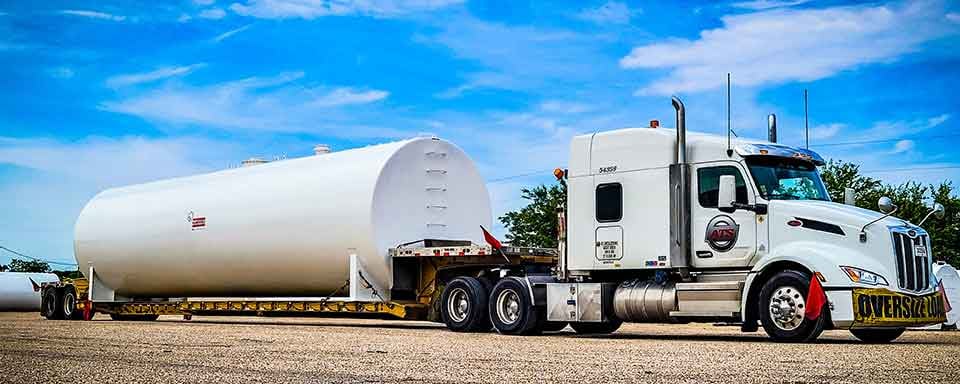- Oversize load definition
- Legal limits for weight, width, height and length
- Permitting requirements
- Your role in successfully moving oversize freight
In the trucking industry, size matters. Freight size determines what type of vehicle will be used, the route it will travel and what additional costs and permits will be needed.
Legal load limits across the country are set by each area’s infrastructure — road widths, bridge heights and weight limits. These legal limits vary slightly by region (older infrastructure tends to be smaller), as does the process for permitting oversize (OS) loads.
But when freight has to move, there’s no time to be overwhelmed by limitations and requirements.
At Anderson Trucking Service (ATS), we move all sizes of freight every day. Our drivers and office staff have real-world experience specifying vehicles, sourcing permits and arranging for specialized accommodations like pilot cars.
We’re happy to share our experience in keeping the roads a safe and friendly place for everyone, and to help you determine if your next shipment will need a permit or other over-dimensional (OD) accommodation.
Defining an Oversize Load
The first step in planning an oversize shipment is knowing the size of your freight and how that compares to legal limits at the point of origin, destination and all points in between. Freight is measured in four dimensions: weight, width, height and length.
If all four dimensions are within legal limits, congratulations! You can safely ship without additional considerations. However, if one or more dimensions exceeds regulations, you will need to prepare for an oversize shipment.

Legal Weight Limits by Trailer Type
The legal weight limit for vehicle and freight is 80,000 pounds total gross. This means that the weight available for the freight is 80,000 minus the weight of the vehicle. Typical limits are:
- Dry van: 45,000 lbs.
- Flatbed trailer: 46,000-50,000 lbs., depending on the style of trailer
- Step decks: 44,000 lbs.
- Conestoga trailers: 42,000 lbs.
- Curtainside trailers: 42,000 lbs.
- Expandable drop trailers: 40,000 lbs.
- RGN/double drop trailers: 38,000 lbs.
- Expandable RGN: 35,000 lbs.
- Hotshot trailers have a variable maximum weight based on the trailer size and truck capacity. The freight limit is usually 15,000 lbs.
This limitation comprises the weight of the freight plus the pallet or shipping container. Precision matters — if your freight is nearing the limit, measure carefully to determine if you are within limits or overweight.
Need help planning a flatbed load? Download the Flatbed Carrier Selection Checklist.
Legal Freight Width Limits
The nationwide width limit is 8 feet, 6 inches. This is the width of most trailers, so as long as your freight fits within the confines of the trailer you are able to load without additional permits.
Even if your freight is smaller than the legal limits, it is important to specify it accurately. The width of the freight will determine what dunnage, tie downs and tarps the driver needs to prepare to keep your load safe during transit. Having accurate measurements at the beginning will save everyone time and will likely save on future surcharges.
Legal Freight Height Limits
Nationwide, the maximum height for the trailer and freight ranges from 13 feet, 6 inches (typically east of the Mississippi) to 14 feet (most areas west of the Mississippi). Depending on where you will be traveling, you will need to prepare to stay under these limits or incur the cost of additional permits.
Dry vans are always within the legal height limit. If you are shipping on a flatbed trailer, you will need to specify the height to ensure you have the right type of trailer. While a typical flatbed is 5 feet high, there are alternatives for tall cubes and taller freight.
Legal Freight Height on a Step-Deck Trailer
Step-deck trailers are 3 feet, 4 inches off the ground. This leaves up to 10 feet, 2 inches available for freight and packaging.
Legal Freight Height on an RGN
RGNs or “removable gooseneck trailers” are meant to haul heavy equipment. The gooseneck attachment of these trailers is designed to allow equipment to roll on/roll off.
The RGN trailer is one of the lowest available. Commonly only two feet off the ground, these trailers leave 11 feet, 6 inches for the height of the freight.
Legal Freight Length Limits
Standard trailers in the trucking industry are 48-feet or 53-feet long. If the length of your commodity fits within the legal confines of the trailer, you will not require additional permitting.
Many states allow a small amount of length overhang on a 48-foot flatbed trailer without permitting. Typically this amount is two feet off the front of the trailer and three feet off the rear. This requirement varies by state and requires the freight to be self-supporting. Usually, overhang from a 53-foot trailer requires a permit.
Once you have determined that one or more dimensions of your freight are oversize, it’s time to consider permitting options.
Avoid Oversize Freight by Transloading to Multiple Vehicles
If your commodity can be divided among two or more trucks, that can help get it down to the legally allowed dimensions. A divisible load is legally required to use multiple vehicles.
Of course, this won’t work with large items that can’t be divided, like heavy equipment. But if you are moving a large number of smaller objects, it may be necessary to move the load in multiple trips.
Hauling Oversize Loads: Permits Are Required
If your freight exceeds the legal limit in one or more dimensions and can’t be divided, permits will be needed before the driver leaves your point of origin.
The easiest way to deal with oversize freight is to partner with a carrier or permitting company who has experience in the process. Unless you are prepared to deal with multiple permits, oversize load limitations around holidays, route planning and potentially escort cars for larger oversized loads, you will save significant time (and likely unexpected costs on the back end) by trusting the experts.
Up to a certain limit (typically 10-feet wide or 10,000 lbs. over the legal weight), a basic permit is required for each state you will be traveling through. You should expect to pay $100-$300 per state for permitting, no matter how many dimensions your vehicle exceeds (for example, one permit can cover both overwidth and overweight).
Special Considerations for Heavy Haul Freight
Heavy haul loads (greater than 14-feet, 6-inches wide or 55,000 lbs. piece weight) require specialty permits, and sometimes specialty engineering services. Depending on the route, you may need to attain permits in every jurisdiction (state, county or city). These permit costs will vary widely and may depend on factors such as permitted miles.
Heavy haul loads may also incur costs above permitting, including pre-trip planning, escort vehicles, patrol escorts, bridge engineering review and more. If you are not prepared to plan these details yourself, contact an experienced permitting company or a full-service carrier like ATS.
Your Role in Successfully Shipping Oversize Freight
No matter the size of your commodity, there’s a way to safely transport it. Legal limits ensure the roads are safe for everyone, and the permitting process helps you safely move your freight, no matter the size and shape.
As the customer, the most important thing you can do is take the time to accurately specify the type of commodity you will be shipping, along with its total weight, width, height and length. Precision matters — being off by even a few inches or a few pounds can cause headaches and delays while your freight is en route to the final destination.
While it is possible to get permits while your freight is in motion, it will ultimately save time and money to plan ahead. You can partner with a Permit Coordinator at your carrier of choice, or research each jurisdiction to find out their permitting requirements.




